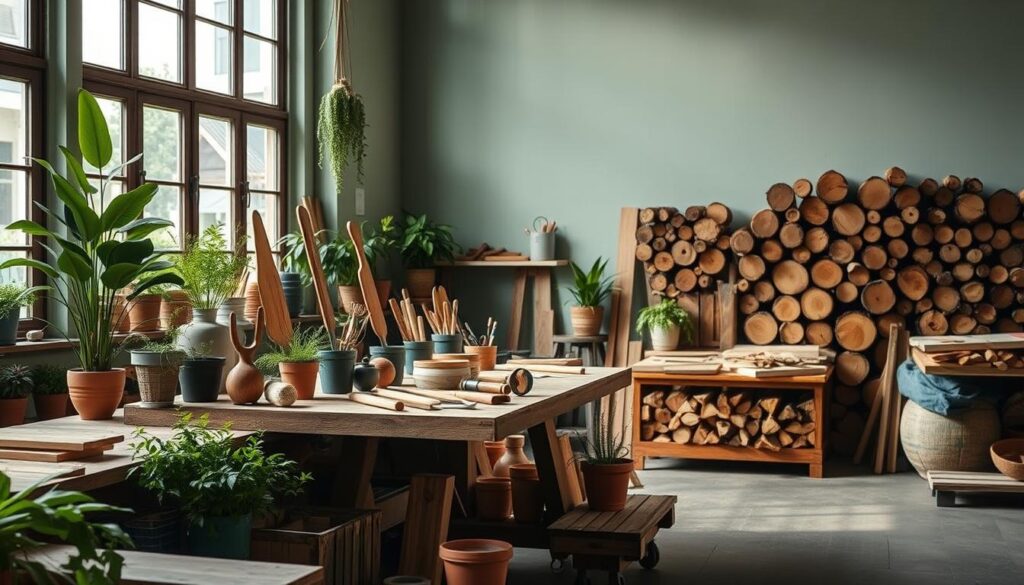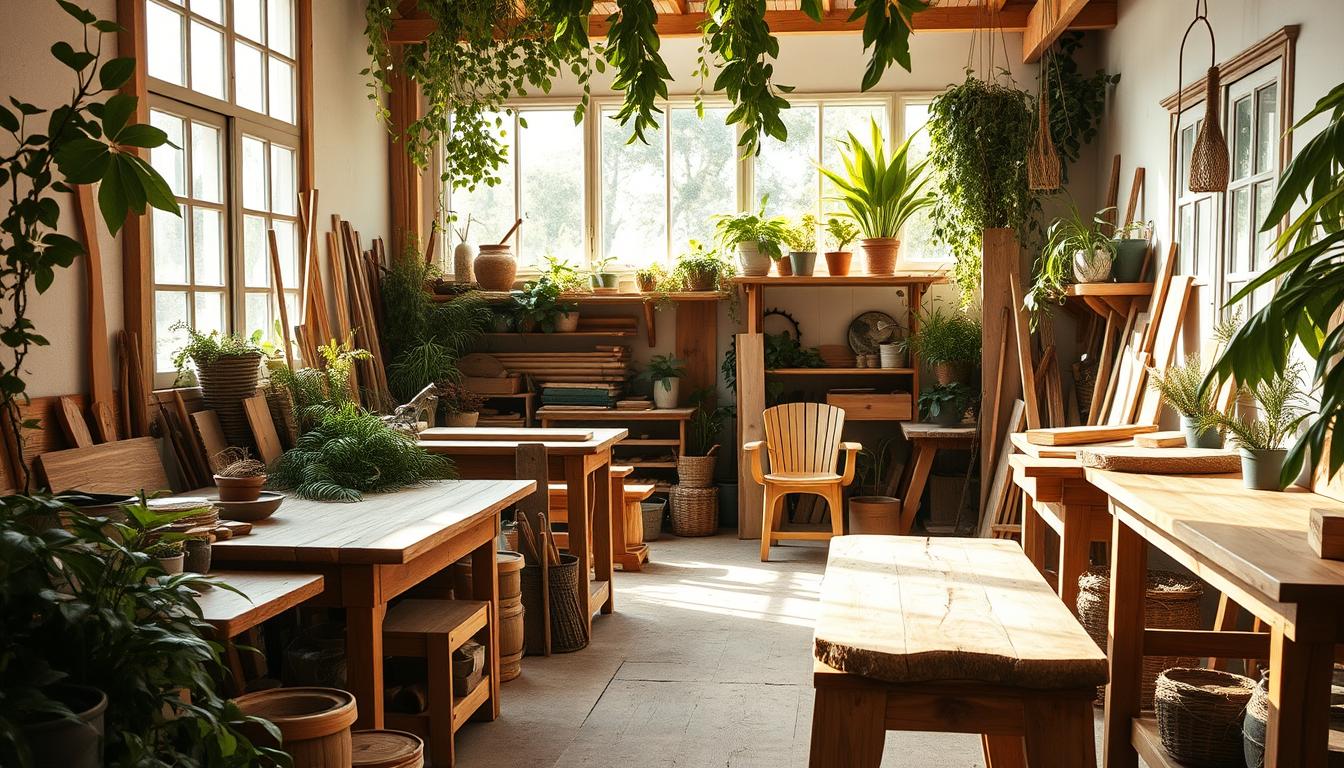Walking past the wood stacks, I think about our choices. They affect our work and the planet. Eco-Friendly Woodworking Practices are key to a greener future for woodworking.
In our community, we’re sharing tools. This cuts down on waste and brings us closer together2. It shows how teamwork can make a big difference in our craft.
Table of Contents
ToggleKey Takeaways
- Adopting woodworking practices that prioritize the planet’s health contributes to a sustainable future.
- Utilizing materials with fewer VOCs can protect our shared environment and the well-being of craftsmen1.
- Investing in FSC-certified wood is a commitment to responsible forest management2.
- Community engagement in sharing resources profoundly impacts environmental sustainability2.
- Recycling and repurposing wood and other materials can significantly reduce demand on landfills1.
- Sustainable practices ensure the persistence and evolution of woodworking for generations2.
>>Get 16,000 Woodworking Plans
Understanding Eco-Friendly Woodworking
Woodworking and caring for our planet go hand in hand for me. Making eco-friendly choices in my craft is rewarding and essential. Eco-friendly woodworking is more than just actions; it’s a deep commitment to nature.
What is Eco-Friendly Woodworking?
Eco-friendly woodworking means using methods that protect forests and reduce carbon emissions. It’s about choosing sustainable options to help the environment. This way, I help prevent biodiversity loss and fight climate change3.
It also ensures woodworking resources last longer. This lets the craft grow without harming nature3.
Benefits of Sustainable Practices
Choosing local wood reduces carbon emissions and supports local economies3. This makes my projects better for the planet and people.
To learn more, check out this guide on sustainable woodworking practices. See how you can make your projects greener4.

Switching to sustainable woodworking is more than new techniques. It’s changing how we see woodworking for the future. Every choice we make helps create a greener world for all4.
Sourcing Sustainable Materials
In our quest for eco-friendliness in woodworking, choosing materials is key. Sustainable wood sourcing is essential for forest conservation and eco-friendly crafting. By using FSC-certified wood, reclaimed materials, and local wood, we can lessen our environmental impact.
Certified Wood Options
Such materials meet high environmental and social standards. They are perfect for projects that value both beauty and sustainability.
Reclaimed Wood Use
Local vs. Imported Wood
Using local wood is a key part of sustainable woodworking. It cuts down on carbon emissions from transportation. Local wood supports the local economy and reduces environmental harm8.
Choosing local woods helps decrease our carbon footprint. It allows us to create beautiful, sustainable products.

Every material choice affects woodworking’s sustainability. Understanding these impacts helps preserve our planet and woodworking’s future. Learn more about sustainable woodworking practices at wood-2art.com.
| Material Type | Sustainability Factor | Typical Uses |
|---|---|---|
| FSC-Certified Wood | High | Furniture, building materials |
| Reclaimed Wood | Very High | Flooring, art pieces |
| Local Wood | High | Decorative items, local construction |
Tools and Techniques for Green Woodworking
As a woodworking enthusiast, it’s key to use tools and methods that are good for the environment. Eco-friendly woodworking practices help reduce our impact on the planet. They let us create art and useful items in a way that’s kind to the Earth.
Choosing Eco-Friendly Tools
Choosing the right tools is crucial for green woodworking. Hand tools like hatchets, froes, drawknives, and adzes keep traditions alive. They also help us avoid the energy use of power tools.
Reducing Energy Consumption
When we must use power tools, choosing energy-efficient machinery is key. These tools use less electricity and work better than old ones. Using them helps cut down energy use, which is good for the environment9.
Working with local suppliers and sawmills also helps. It means we use materials from nearby, which cuts down on emissions. It also helps our community and supports local businesses9.
>>Get 16,000 Woodworking Plans
| Eco-Friendly Tool | Usage | Benefit |
|---|---|---|
| Hatchets | Shaping, splitting wood | Minimizes waste; no electricity needed |
| Froes | Splitting logs | Improves wood strength and efficiency |
| Drawknives | Shaping and refining lumber | Allows for fine precision and detailing |
| Spokeshaves | Smoothing flat and curved surfaces | Reduces need for sandpaper and chemicals |

Waste Reduction Strategies
Reducing waste in woodworking is good for the planet and saves money for woodworkers. By recycling wood and using sustainable cutting methods, we can greatly reduce our environmental impact.

Efficient wood cutting is key to reducing waste. Advanced planning and modern tools like CNC machines help woodworkers make precise cuts. This means less waste and more material use11.
Efficient Wood Cutting Techniques
Recycling and Repurposing Scraps
Recycling wood goes beyond just throwing away waste. About 30% of wood scraps are turned into useful items like picture frames or small furniture12. This approach supports a circular economy and adds creativity to woodworking.
Finishing Products with Low Environmental Impact
I’m a woodworking enthusiast who loves the planet. I choose products that are good for the environment and our health. I’ve found many natural and non-toxic wood treatments that help a lot.
Natural Finishing Options
Natural finishes have changed my woodworking. Water-based and plant-based solutions are now available. They have very low VOC levels, unlike old finishes.
Rubio Monocoat’s technology is amazing. It protects wood quickly, bonding in seconds14.

Non-Toxic Wood Treatments
It’s important to use non-toxic treatments. Many eco-friendly finishes have no VOCs, water, or solvents. They’re perfect for a safe workspace15.
These products are safe and meet high standards. They often get certifications like GREENGUARD14.
Using green finishes and non-toxic glues helps the planet. It also makes my projects better and longer-lasting. Choosing eco-friendly options is a step towards a healthier world.
>>Get 16,000 Woodworking Plans
Sustainable Design Principles
In my journey toward mastering eco-friendly woodworking practices, I’ve learned a lot. I now focus on simple designs and multi-functional projects. This helps me make a difference in woodworking’s future.
This approach meets both beauty and function needs. It also helps reduce our environmental impact.
Simplicity in Design
Adopting simple designs cuts down waste and saves resources. This is at the heart of sustainable design. It means making pieces that are easy to make and last long.
Multi-Functional Projects
I also focus on making furniture that does more than one thing. This makes it last longer and be more useful. It saves resources and meets today’s living needs.
Designing furniture that can change its use is key. It means we don’t need as many pieces. This reduces the resources used over time. Using FSC materials ensures my work is eco-friendly18.

Eco-friendly woodworking is about responsible making, from start to finish. Using water-based finishes is one way to do this. It cuts down on harmful chemicals in the air16.
Working with local suppliers and using sustainable materials also helps. It lowers carbon emissions and supports local economies18.
As I keep improving, sustainable design is more important to me. It drives me to create better, greener woodworking. Each piece shows my commitment to beauty, function, and the planet’s health.
Community Engagement in Woodworking
In today’s world, caring for the environment is key. Eco-friendly woodworking is crucial. It helps our planet and boosts local economies.
Supporting Local Artisans
Choosing local artisans who use urban trees is a big step. It’s a move towards a greener, community-driven economy. Woodworking with these materials saves forests and conserves resources19.
Participating in Workshops
Local workshops are key for learning eco-friendly woodworking. They teach us to use resources wisely and reduce waste. This helps our planet.
These workshops also teach us to use local, sustainable wood. They help build a culture of sustainability in our community20.
In conclusion, eco-friendly woodworking is more than making sustainable products. It’s about creating strong, caring communities. Every step we take helps our communities and the planet. We’re making a difference for the future.
Woodworking and Carbon Footprint
I’m dedicated to making woodworking more sustainable. I focus on reducing my carbon footprint in my workshop. I use eco-friendly practices and choose wood from responsible forestry.
Understanding Carbon Capture
Trees are great at capturing carbon. By using urban forestry products and reclaimed wood, I help the environment. I also support local economies21.
I prefer hand tools over power tools. This choice helps reduce my carbon footprint. It also makes my workspace quieter and cleaner22.
Reducing Your Footprint
Minimizing waste is key. I use efficient cutting layouts and repurpose scraps. This helps a lot21. I hope to encourage others to adopt greener woodworking practices.
>>Get 16,000 Woodworking Plans
FAQ
What is Eco-Friendly Woodworking?
Eco-friendly woodworking means using green practices in woodworking. This includes getting wood from well-managed forests and cutting down waste. It also means using eco-friendly finishes and reducing carbon emissions. The goal is to make wood products that are good for the planet.
What are the Benefits of Sustainable Practices in Woodworking?
Sustainable woodworking helps protect forests and makes manufacturing better. It also cuts down on harmful emissions. This approach saves natural resources, can save money, and makes a healthier work place.
What are Some Certified Wood Options?
Certified wood comes from forests that are managed well. It’s certified by groups like the Forest Stewardship Council (FSC). This wood is good for the environment, people, and the economy.
How is Reclaimed Wood Used?
Reclaimed wood comes from old buildings and barns. It’s cleaned and used for new projects. This way, we avoid wasting wood and add character to our work.
Should I Choose Local or Imported Wood?
Local wood is better because it cuts down on carbon emissions from transport. It also supports local economies. Plus, it’s more likely to meet local forestry standards.
How Can I Choose Eco-Friendly Tools?
Use hand tools when you can to save energy. If you need power tools, choose ones that use less energy. This helps reduce your carbon footprint.
What are Effective Ways to Reduce Energy Consumption in Woodworking?
Use energy-saving tools and keep them in good shape. Plan your projects to use power tools less. This cuts down on energy use.
What are Efficient Wood Cutting Techniques?
Plan your cuts to waste less wood. Use the right blade for the job and make precise cuts. This saves resources and reduces waste.
How Can I Recycle and Repurpose Scraps?
Turn wood scraps into new projects, mulch, or fuel. This reduces waste and gives old wood a new life.
What Natural Finishing Options are Available?
Use plant-based oils and waxes like linseed oil and beeswax. They’re good for the environment and make wood look great without harmful chemicals.
Which Non-Toxic Wood Treatments Should I Use?
Choose water-based finishes and low-VOC varnishes. Natural oils are also good. They’re safer for you and the planet.
Why is Simplicity in Design Important in Sustainable Woodworking?
Simple designs use fewer resources and waste less. They also make durable products that last longer. It’s good for the planet and looks timeless.
What Constitutes a Multi-Functional Woodworking Project?
Multi-functional projects do more than one thing. They last longer and use less. This reduces waste and saves resources.
How Does Supporting Local Artisans Contribute to Sustainable Woodworking?
Supporting local artisans keeps traditions alive. It cuts down on emissions from transport. It also supports local economies and promotes green practices.
What is the Importance of Participating in Workshops?
Workshops teach new eco-friendly techniques. They bring people together and share ideas. It’s a chance to learn and improve green woodworking.
How Can Woodworking Contribute to Carbon Capture?
Wood naturally stores carbon dioxide. By using wood and planting trees, woodworkers can help capture more carbon. This is good for the planet.
In What Ways Can I Reduce My Woodworking Carbon Footprint?
Use sustainable wood, energy-efficient tools, and reduce waste. Choose non-toxic finishes and support local suppliers. These steps help make woodworking more eco-friendly.
Source Links
- 5 Tips for Eco-Friendly Woodworking – https://greenbuildingcanada.ca/5-tips-eco-friendly-woodworking/
- Sustainable Woodworking: Eco-Friendly Practices – https://wood-2art.com/blogs/news/sustainable-woodworking-practices?srsltid=AfmBOoqnTMHjYptOgHUpiF1n1jxuEYQP09m3gri_oaz0eVvLDJmcSctE
- Sustainable Woodworking: Eco-Friendly Practices – https://wood-2art.com/blogs/news/sustainable-woodworking-practices?srsltid=AfmBOorZFgKO0sdw8fkz77U-fXCrpQpXyK_iEC9A1nNeNmTP-X8jcTPQ
- Woodworking and Sustainable Living Woodworking and Sustainable Living – https://www.fouroakscrafts.com/woodworking-and-sustainable-living/
- A Comprehensive Guide to Eco-Friendly Woodworking Practices – Elin and Lia Cabinet Manufacturing – https://elinandliya-cabinet.com/crafting-a-sustainable-legacy-a-comprehensive-guide-to-eco-friendly-woodworking-practices/
- A Guide to Sustainable Woodworking: Choosing Eco-Friendly Materials and Techniques – Delta Woodworks Cabinets – https://deltawoodworksfl.com/a-guide-to-sustainable-woodworking-choosing-eco-friendly-materials-and-techniques/
- Choose Sustainable Wood: Eco-Friendly Carpentry Tips | AG Kerr Carpentry – https://www.agkerrcarpentry.co.uk/blog/how-to-choose-sustainable-wood-for-carpentry-projects
- Eco-Friendly Products for the Eco-Conscious Woodworker – Bessemeter – https://www.bessemeter.com/blog/embracing-eco-friendly-products-for-wood-working/?srsltid=AfmBOop8nuwwq4a7AfkPchsZ98I6j6PkuixHP1mbKxNTI2JLVyMUNv4M
- Sustainable Woodworking: Eco-Friendly Practices – https://wood-2art.com/blogs/news/sustainable-woodworking-practices?srsltid=AfmBOorOFp1ZGEi1cKpTtNnvRwGHsI1qDBnVBmaX9-YRvwWDOjz50wLp
- Hand Tools Used for Green Woodworking: Back to the Roots – https://kmtools.com/blogs/news/green-woodworking-tools?srsltid=AfmBOoqIROiiP1zUJHa4Mp0z6qor3SEUwxksrH1RgVYD-lagWwlJlNie
- Minimizing Waste in Woodworking: Embracing Sustainability for a Greener Future – https://www.linkedin.com/pulse/minimizing-waste-woodworking-embracing-sustainability-ziyad-ahmadli
- Sustainable Carpentry: Reducing Waste in Woodworking – https://carpenterus.com/blog/sustainable-carpentry-reducing-waste-in-woodworking-projects/
- Sustainable Woodworking: Eco-Friendly Practices – https://wood-2art.com/blogs/news/sustainable-woodworking-practices?srsltid=AfmBOoqtYl1X1UU1MY1P3TyNsslHxBAHNRrDRziC5CBPK11pDV6pfJHl
- Eco-Friendly Hardwood Floor Finish Products and Discussion – https://1dayrefinishing.com/blog/eco-friendly-hardwood-floor-finish/
- Sustainable Woodworking Hacks You Need to Try – https://woodenedgestudios.com/sustainable-woodworking-practices/
- Sustainable Wood Choices for Eco-Friendly DIY – https://hi-spec.com/blogs/news/sustainable-wood-choices-for-eco-friendly-diy
- Mock Woodworking’s Best Sustainable Wood Practices – Mock Woodworking – https://www.mockwoodworking.com/mock-woodworkings-best-sustainable-wood-practices/
- Sustainable Woodworking: Eco-Friendly Practices – https://wood-2art.com/blogs/news/sustainable-woodworking-practices?srsltid=AfmBOoox_ReDd-4XQxSja1EoM4aaojo8Fk2hQsfJcr14hFqD3iXMcC5L
- Sustainable Woodworking: The Benefits of Using Urban Trees – https://wycowoodco.com/blog/sustainable-woodworking-the-benefits-of-using-urban-trees
- Sustainable Woodworking: Reducing Waste and Maximizing Resources in the Shop – Wood Craft Parts – https://woodcraftparts.net/sustainable-woodworking-reducing-waste-and-maximizing-resources-in-the-shop/
- Sustainable Woodworking: Eco-Friendly Practices – https://wood-2art.com/blogs/news/sustainable-woodworking-practices?srsltid=AfmBOorPa2dTkV5QNV9jw9rbFuBZZeoRM9XKsMpwuBFjPtu_ZlcbAAyG
- Eco-Friendly Products for the Eco-Conscious Woodworker – Bessemeter – https://www.bessemeter.com/blog/embracing-eco-friendly-products-for-wood-working/?srsltid=AfmBOoqMUd63Y49KynXRug_fCJ7b3nODMgRS4nJX4Gve8upEFYTKSc6j

